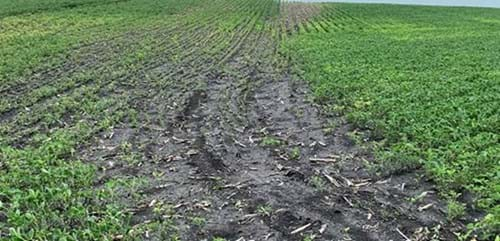Agronomy Update: Watching for Corn Tassels, Apply vs. Not Applying Fungicides, and Those “I Don’t Know Spots” in the Fields
BY DAIRYLAND SEED AGRONOMY TEAM
Corn Pollination
Corn tassels will soon fly over the fields of the midwestern United States! Their emergence marks the final vegetative growth stage of the corn crop, VT. Pollen shed begins shortly after tassels peek out of the canopy and will continue for 7-14 days depending on weather conditions and hybrid genetics. The emergence of silks from the ear shoot marks the beginning of the reproductive growth stages, R1.
Pollen must be shed when receptive silks are present for a crop to ‘nick,’ that is to say, successfully pollinate. Hopefully this is obvious, but take a minute to think about how this establishes the actual number of kernels per ear, while potential kernel size is still being determined in the plant. Pollination turns the switch on for each kernel, which will later fill out with the energy resources that are being collected inside the plant tissue.
Silks have a high water content and are thus driven by soil moisture conditions. Where irrigation resources are available, this is one of the most critical time periods to monitor. The crop is using more than 0.25” of water per day at this point. Dry weather conditions as of late could threaten pollination in certain areas, but usually just a brief shower can alleviate any delayed silk emergence. If you smell pollen while driving past a field, look for silk growth to identify any potential issues. A few days after pollen shed has completed, you can assess pollination by carefully husking ear shoots and observing the number of silks still attached to kernels. Silks will readily fall away from fertilized kernels while silks will still cling to unfertilized kernels.
Pray for rain to get through pollination, but those high energy storms can bring other risks. The late vegetative stages are a period of rapid growth, which can make plants brittle and prone to green snap and summer lodging. The VT-R1 stages are also very susceptible to defoliation. Severe hail storms can lead to 100 percent yield loss at this point by preventing pollination and/or by reducing kernel size potential.
While we cannot manage some of these things in the moment, you have been doing so all season without really acknowledging it. Hybrid selection that includes a variety of hybrids and maturities spreads the risk of environmental conditions and variable planting dates can have the same impact. General plant health is also an important factor. A healthy plant is better at fighting off disease, recovering from weather events, and tolerating momentary stress during pollination. Do not under value the importance of your early season efforts towards general plant health as you sit back and watch natural biology do its job.
To Apply or Not to Apply Fungicides on Corn and Soybeans
Fungicide applications will help control certain foliar disease in corn and soybeans. However, applying fungicides blindly will not necessarily provide a return on your investment. The decision to apply a fungicide should take into account the susceptibility of the hybrid or soybean variety to foliar disease. A highly resistant hybrid or variety will have a low risk for disease to develop and most likely not provide an economically beneficial result. On the other hand, a susceptible hybrid or variety will potentially give a positive return on a fungicide investment if weather conditions are conducive for disease development.
Weather is a huge factor in whether or not fungal disease will develop. Past, present and future weather events should be considered along with scouting to determine if a fungicide should be considered. Rain, high humidity, fog and dew will provide the moisture on plant surfaces that fungal disease requires to develop. The number of days/hours with moisture on plant surfaces, along with various temperature parameters for disease to develop, are all required to produce fungal disease.
Basically, if moisture events have occurred and temperatures are above 75 degrees for two or more days within a four-day period AND predicted for two or more of the next five days, a fungicide may be considered for a susceptible variety or hybrid.
“I Don’t Know Spots”
We are that point in the growing season where we have transitioned from spraying Post Emergence Corn herbicides to spraying Post Emergence Soybean Herbicides. As we move from spraying a corn herbicide to spraying a soybean herbicide, remember that many corn herbicides can cause crop injury to the soybean crop. These injury symptoms can cause the dreaded “I don’t know spots,” which we see from time to time, and are often the point of discussion at locations where coffee or other beverages are partaken in.

To prevent potential herbicide injury, take the time to clean and rinse out the sprayer when switching between crops. If you read the herbicide label of the product you last applied, it will provide you the proper spray tank cleaning instructions. What I suggest is to drain the sprayer, then fill the sprayer half full with water, making sure to spray down the inside of the tank, add a quality tank cleaner, then fill the tank to capacity with water. Agitate this mixture for 15+ minutes to flush water and tank cleaner through the spray system. (In a perfect world this is where I would shut the sprayer off and let the tank cleaner mixture sit overnight.) After this mixture has set for a period of time, drain the tank, pulling nozzles, filters and screens cleaning them separately in the tank cleaner or ammonia mixture. An area of the sprayer or spray line that is often overlooked for product that may “hang up” or have a tough time rinsing are end caps. It is best if they are pulled and cleaned as well. Rinse the tank, nozzles, filters, end caps and screens with clean water, then drain.
Remember to read herbicide labels and what the proper tank cleaning procedures are for those products, following these instructions will help to fend off the dreaded “I don’t know spots.”
Corteva Technology Use Agreements
All growers with orders for any Corteva Agriscience brand seed product, regardless of crop or trait (including non-GM products) need to have a signed Corteva Technology Use Agreement in place by September 1. Growers should sign the Corteva Technology Use Agreement electronically at www.agcelerate.com. Signing electronically is preferable, however, paper copies are available at www.traitstewardship.com.
 |
 |
 |
 |
 |
| Brian Weller Western Region 507.456.3034 |
Dan Ritter Central Region 219.863.0583 |
Branden Furseth Northern Region 608.513.4265 |
Rod King Eastern Region 574.596.6721 |
Terry Jones Eastern Region 419.630.3115 |
